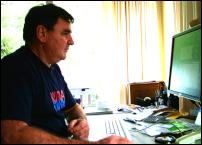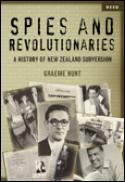Graeme Hunt's Book on New Zealand Spies and Revolutionaries – Chapter Seven: Trinity’s traitor
Scoop is serializing the first 1000 words of each chapter of author Graeme Hunt's latest book: Spies And Revolutionaries – A History of New Zealand Subversion. Click here for Chapter Seven: Trinity’s traitor
 The history of New Zealand's intelligence agencies and
those it has spied on have been laid bare in a book by
Auckland-based journalist, author, and historian Graeme
Hunt.
The history of New Zealand's intelligence agencies and
those it has spied on have been laid bare in a book by
Auckland-based journalist, author, and historian Graeme
Hunt.
Spies And Revolutionaries – A History of New Zealand Subversion details how several prominent New Zealanders, all of whom are dead, spied for the former Soviet Union during the Cold War. Accusations and suspicions are laid bare before files and information that has never before been made public. This book will clearly recharge debate as to whether Dr Bill Sutch, diplomat Paddy Costello, and public servant Ian Milner were spies acting against New Zealand's national interest.
CHAPTER
SEVEN: Trinity’s traitor
 In
October 1932 a gangly 20-year-old wearing black horn-rimmed
glasses enrolled at Trinity College at the University of
Cambridge at the start of Michaelmas term. He was
extraordinarily bright –– fluent in Latin, Greek and
French –– and already holding a double-first MA from
Auckland University College. His name was Desmond Patrick
Costello –– ‘Des’ to his family and later
‘Paddy’ to his friends –– and he was to become the
most important New Zealand spy recruited by the Soviet
Union.
In
October 1932 a gangly 20-year-old wearing black horn-rimmed
glasses enrolled at Trinity College at the University of
Cambridge at the start of Michaelmas term. He was
extraordinarily bright –– fluent in Latin, Greek and
French –– and already holding a double-first MA from
Auckland University College. His name was Desmond Patrick
Costello –– ‘Des’ to his family and later
‘Paddy’ to his friends –– and he was to become the
most important New Zealand spy recruited by the Soviet
Union.
Unlike many of his Cambridge contemporaries, Costello’s road to traitorhood was not paved in gold. He was born in the working-class Auckland suburb of Eden Terrace, the fourth of eight children of Christopher Costello, a Dublin-born Irish Catholic, and his Australian-born wife, Mary. The family was ‘highly respectable … and completely loyal’, according to police reports, and Des appears to have been the only radical.
Christopher, a publican’s son, was a self-employed grocer in middle-class Devonport by the time Des reached school age. The family lived behind the store and Des was five minutes’ walk from St Leo’s Convent School, where he enrolled in February 1917, a few days after his fifth birthday. Tragedy struck in September 1923 when Christopher died of heart failure after the rupture of a duodenal ulcer. He was only 56 and his estate, worth a net £3234 –– a tidy sum for the times –– proved insufficient to meet the needs of his widow and children, six of whom were still dependent on him.
Des had been at Auckland Grammar School, the city’s top state secondary college, for two terms when his father died. He was 11 years eight months old, two years ahead of most pupils in his class, and had got there on ability after winning a Rawlings scholarship at Ponsonby School in 1922. He had transferred to Ponsonby three years earlier from St Leo’s, perhaps to boost his prospects for getting into high school. The scholarship not only gained him entry into Grammar but also entitled him to £10 a year and free stationery.
Costello demonstrated his brilliance through his studies but he did not take part in sports or social activities. He was, recalled one of his Grammar masters, ‘a student of outstanding ability, probably … the most brilliant of his time’ with ‘plenty of common sense … [and] none of the erratic or unbalanced tendencies so often associated with brilliance …’
As a fourth-former in 1924, Costello was one of 11 students to win senior national scholarships. The following year, in the fifth form (division A), he was ranked ninth in English, third in Latin and fifth in French for his school. In the sixth form (division B) in 1926 he topped English, Latin and French and passed with credit for a university national scholarship. In the upper sixth form in 1927 –– his last year at high school –– he was fourth in English, second in Latin and second in French. He won the junior Eric Hooton prize for English essay, was the top Auckland Grammar School student based on public examinations (though not top in school results) and awarded the Lizzie Rathbone scholarship for English and history for 1928.
At age 16 Costello enrolled at Auckland University College, taking Latin, Greek, French and history (and, the following year, Hebrew) towards a BA. His marks in Latin and Greek earned him a senior scholarship in both subjects and a Greek scholarship in 1930. He completed his BA in 1931 and his MA the following year with first-class honours in Greek and Latin. He was awarded a post-graduate arts scholarship in April 1932, giving him the means to go to Cambridge.
It was at Auckland University College, according to his security intelligence file, that he first challenged traditional beliefs, renouncing religion for ‘some form of agnosticism or atheism’. He also kept company, according to one report, with a group ‘noted for its radical tendencies … [and] Communist leanings’ and was a member of Auckland University College Students’ Association executive, though not a prominent activist.
He was not influenced politically by his classics masters. His Greek and Latin lecturer, Ted Blaiklock, just eight years his senior, was a staunch Baptist without a hint of socialist or revolutionary leanings. And the classics department head, Alfred Paterson, who was Costello’s Hebrew lecturer, was even more conservative. If anyone could have ‘turned’ Costello to the left, it would have been his mild-mannered history lecturer, Bill Airey, but this was not Airey’s style and, until 1930 at least, Airey was more interested in the League of Nations and New Zealand Student Christian Movement than Marxism. History, in any case, was Costello’s weakest subject at the college and really a ‘make-weight’ option only in his academic career. More likely, Costello fell under the influence of a couple of bright fellow students, James Bertram and Griff Maclaurin.
Bertram, the son of a Presbyterian minister, was editor of the Student Christian Movement magazine Open Windows, assistant editor of the student journal the Kiwi and editor of the first two issues of the literary magazine the Phoenix. He would become a Rhodes scholar in 1932 and, after a period at the University of Oxford, make his name as the ‘British’ journalist who met Mao Tse-tung and other top communists during an extended tour of China in 1937.
Maclaurin, a mathematician and nephew of New Zealand’s most brilliant mathematician, the late Richard Maclaurin, had been at Grammar with Costello and was also destined for Cambridge (they would travel together). But Maclaurin would struggle at St John’s College, despite his initial promise, and graduate in 1934 with a BA with third-class honours. He would open a successful left-wing bookshop in Cambridge in 1935 but would be killed in action in the defence of Madrid the following year, soon after joining the Republican side in the Spanish Civil War.
Costello could not have known what was in store for Maclaurin and if he was stirred politically in Auckland it did not distract him from his studies; Cambridge was to have a far greater influence on his life. He entered this old and venerated institution in the midst of an international Depression when the Communist Party of Great Britain was working hard to win the hearts and minds of young academics. The university had no official communist club –– communists distinguished themselves by trying to take over the Socialist Club –– but there was a secret communist cell at Trinity College.
Costello, who lived in digs (initially at 63 Maid’s Causeway) rather than in college rooms, joined the Trinity cell soon after arriving and was probably recruited at the same time to the GRU, the chief intelligence directorate of the Soviet armed forces. His spymaster was probably Anthony Blunt, a fellow of Trinity, who recruited or assisted several other students to commit treason. These included the notorious quartet of Kim Philby, Guy Burgess, Donald Maclean and John Cairncross –– the group, with Blunt, now known as the Cambridge spy ring –– Herbert Norman, a Canadian diplomat later accused of spying, and, possibly, Alan Nunn May, the physicist convicted of atomic espionage in 1946.
See Also:
Scoop is serializing the first 1000 words of each chapter of author Graeme Hunt's latest book: Spies And Revolutionaries – A History of New Zealand Subversion.
SRP: $29.99
ISBN:
9780790011400
340p, includes index, black and white
photos
Reed Publishing (NZ) Ltd www.reed.co.nz
Release: August 6 2007
For more, see… Reed Publishers, Spies And
Revolutionaries



 Binoy Kampmark: Fantasy And Exploitation | The US-Ukraine Minerals Deal
Binoy Kampmark: Fantasy And Exploitation | The US-Ukraine Minerals Deal Gordon Campbell: On The Aussie Election Finale
Gordon Campbell: On The Aussie Election Finale Martin LeFevre - Meditations: The Enlightenment Is Dead; What Is True Enlightenment?
Martin LeFevre - Meditations: The Enlightenment Is Dead; What Is True Enlightenment? Ian Powell: Widening Gap Between Health System Leadership And Health Workforce
Ian Powell: Widening Gap Between Health System Leadership And Health Workforce Keith Rankin: The Great World War 1914-1945 - Germany, Russia, Ukraine
Keith Rankin: The Great World War 1914-1945 - Germany, Russia, Ukraine Gordon Campbell: On Our Austerity Fixation And Canada Staying Centre-left
Gordon Campbell: On Our Austerity Fixation And Canada Staying Centre-left